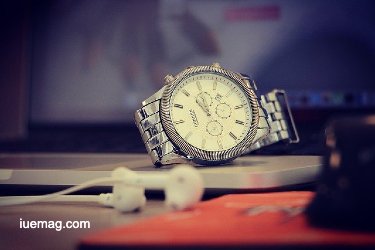

How Do You Pick The Right Watch For Your Wrist?
Trying to decide on a watch model? They come in a number of variants, each a different size and made out of different materials. How would you know which would be the best for your wrists? We’ve talked about this below.
AllergiesWhether you struggle with sensitive skin or not, you want a timepiece that is hypoallergenic; this way it wouldn’t irritate your skin.
One of the most common watch materials you could be allergic to is stainless steel. Manufacturers use nickel when making the metal. Hypoallergenic stainless-steel options are thankfully available.
Case Size The size of a watch depends on the size of its case. Men’s watches have cases between 38 and 46 mm. Anything above 46 mm is big, and anything below 38 mm is small.
The size of a watch depends on the size of its case. Men’s watches have cases between 38 and 46 mm. Anything above 46 mm is big, and anything below 38 mm is small.
You’ll have to measure your wrist. If it’s 6-7 inches, it is small to medium. You’ll need a watch that has a 38- 42 mm case.
A wrist that is 7.5 -8 inches is large. A case that stretches 44-46 mm would be needed.
The size of the case doesn’t influence how it sits on your wrist. This depends on how tight its band is. If you don’t see marks when you take the watch off, it’s not tight. It would be too loose if you can comfortably fit fingers between the strap and your skin.
Band MaterialDepending on whether your wrist is thick or thin, the band you should get would differ. Have thick wrists? Timepieces with leather watch straps would be best – it would make your arm look slimmer.
Interested in a unit with a metal bracelet? Due to the number of links, and the presence of metal, it would look thick even if it’s the same size as a leather band. You commonly see metal bracelets in men’s watches, as their chunky look might not be something women are fans of.
 In general, you wouldn’t want your wrists to look bigger than what they are. But going for a timepiece that make them look bigger could be a personal preference.
In general, you wouldn’t want your wrists to look bigger than what they are. But going for a timepiece that make them look bigger could be a personal preference.
Watch DetailsLook at the components on the device’s face – the seconds hand, hours, pusher, lug size etc. An overly small watch with massive markers, seconds hand, lug size would be disproportionate.
This is also true the of the opposite. If the watch is big but has smaller components, it’ll look unbalanced.
If your timepiece’s crown is big, it won’t look good. But there is a chance that it could poke at your arm too.
Easy-to-ReadLarger watches are easier to read. A watch that is small but has large hour markers would also be easy to read.
Make note of the color on its dial. Something high-contrast would make the hour markers pop. Certain dive watches have bright orange dials to make not hard to read underwater.
Dive watches have large faces, with massive markers full of luminous pigment. This makes them a breeze to read in dim settings.
Considering these points, there is a lot to consider when picking a watch. Ensure that the unit won’t cause allergic reactions and doesn’t look too big. What are your hacks when it comes to choosing the best watch for your wrist? Comment below.
AllergiesWhether you struggle with sensitive skin or not, you want a timepiece that is hypoallergenic; this way it wouldn’t irritate your skin.
One of the most common watch materials you could be allergic to is stainless steel. Manufacturers use nickel when making the metal. Hypoallergenic stainless-steel options are thankfully available.
Case Size
 The size of a watch depends on the size of its case. Men’s watches have cases between 38 and 46 mm. Anything above 46 mm is big, and anything below 38 mm is small.
The size of a watch depends on the size of its case. Men’s watches have cases between 38 and 46 mm. Anything above 46 mm is big, and anything below 38 mm is small.You’ll have to measure your wrist. If it’s 6-7 inches, it is small to medium. You’ll need a watch that has a 38- 42 mm case.
A wrist that is 7.5 -8 inches is large. A case that stretches 44-46 mm would be needed.
The size of the case doesn’t influence how it sits on your wrist. This depends on how tight its band is. If you don’t see marks when you take the watch off, it’s not tight. It would be too loose if you can comfortably fit fingers between the strap and your skin.
Band MaterialDepending on whether your wrist is thick or thin, the band you should get would differ. Have thick wrists? Timepieces with leather watch straps would be best – it would make your arm look slimmer.
Interested in a unit with a metal bracelet? Due to the number of links, and the presence of metal, it would look thick even if it’s the same size as a leather band. You commonly see metal bracelets in men’s watches, as their chunky look might not be something women are fans of.
 In general, you wouldn’t want your wrists to look bigger than what they are. But going for a timepiece that make them look bigger could be a personal preference.
In general, you wouldn’t want your wrists to look bigger than what they are. But going for a timepiece that make them look bigger could be a personal preference.Watch DetailsLook at the components on the device’s face – the seconds hand, hours, pusher, lug size etc. An overly small watch with massive markers, seconds hand, lug size would be disproportionate.
This is also true the of the opposite. If the watch is big but has smaller components, it’ll look unbalanced.
If your timepiece’s crown is big, it won’t look good. But there is a chance that it could poke at your arm too.
Easy-to-ReadLarger watches are easier to read. A watch that is small but has large hour markers would also be easy to read.
Make note of the color on its dial. Something high-contrast would make the hour markers pop. Certain dive watches have bright orange dials to make not hard to read underwater.
Dive watches have large faces, with massive markers full of luminous pigment. This makes them a breeze to read in dim settings.
Considering these points, there is a lot to consider when picking a watch. Ensure that the unit won’t cause allergic reactions and doesn’t look too big. What are your hacks when it comes to choosing the best watch for your wrist? Comment below.
Copyrights © 2025 Inspiration Unlimited - iU - Online Global Positivity Media
Any facts, figures or references stated here are made by the author & don't reflect the endorsement of iU at all times unless otherwise drafted by official staff at iU. A part [small/large] could be AI generated content at times and it's inevitable today. If you have a feedback particularly with regards to that, feel free to let us know. This article was first published here on 18th June 2021.
Overthinking? Uninspired? Brain Fogged?
Let's Reset That! Try iU's Positivity Chat NOW!

All chats are end-to-end encrypted by WhatsApp and won't be shared anywhere [won't be stored either].


